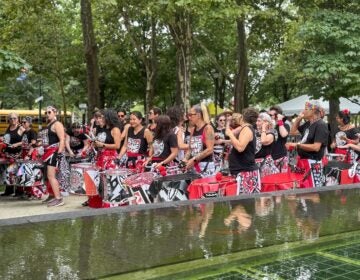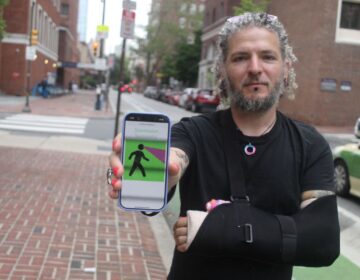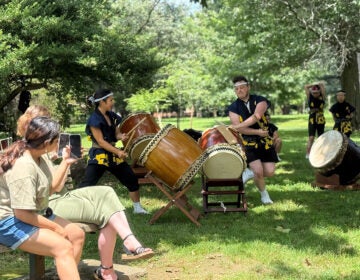The aim at the new St. James – provide top-notch schooling at low tuition
Big changes are in store for the historic St. James the Less site on W. Clearfield Street in the “Lower Falls,” or Allegheny West this year.
The former school at the Episcopal church, vacant since 2006, is being reopened, incrementally, as a middle school for low-income families. This September, the school will open with one fifth grade class consisting of 15 to 17 students.
The idea was sparked by the Rev. Sean Mullen, rector of St. Mark’s Episcopal Church on Locust Street in Center City, Philadelphia.
Mullen had noticed a trend in his congregation: Young families were moving to the suburbs for access to better schools. His initial vision was to open a church school on, or near, the grounds of St. Mark’s to encourage families to stay in the neighborhood, but even he wasn’t sold on his own idea.
“I didn’t have a lot of fire behind the idea in my own heart or mind, but the idea was still in my head,” he said.
Mullen then met John Finley, head of the Epiphany School in Dorchester, Mass. Finley’s school was modeled after the NativityMiguel network, which was established in 2006 to provide low-income families with a quality education.
The 64 schools within this network are in turn patterned after the Nativity Mission Center, which opened its doors in 1971 to middle-school boys growing up in the Lower East side of Manhattan.
The NativityMiguel schools are faith-based and offer extended-day and -year programs at low tuition for traditionally under-served students.
Mullen had found his inspiration.
“I thought, ‘Philadelphia is a city with all sorts of education problems, why can’t we do this there?'” Mullen said.
“He literally had an epiphany, and he realized that was what he should be doing, is opening a school for low-income families and not another prep school,” said David Kasievich, executive director of St. James School.
Mullen considered but discarded the idea of starting the project at St. Mark’s.
“St. Mark’s isn’t surrounded by the kind of demographic that the school ought to be impacting,” he said. “I began to learn about this campus at St. James the Less that was going to be vacated and thought it was the right resource, in the right location, with the right idea.”
The school shares grounds with St. James the Less Church, one of the oldest Episcopal Churches in the country. The church is not normally open to the public but is made available on occasion.
Assessing the need
Mullen spent the next few months walking the neighborhood with his two dogs and talking with neighbors to assess the need for a neighborhood school there. The two main schools in the neighborhood are Rhodes E. Washington Middle School on W. Clearfield Street and John Whittier Elementary School on N. 27th Street.
“The schools in that neighborhood, like many Philly schools, are deeply underperforming, to put it mildly,” Mullen said. “Large percentages of kids, over 50 percent, are leaving well below grade level in math and english and they’re just not being served well.”
After months of research, Mullen asked the Episcopal Diocese of Pennsylvania if St. Mark’s could engage in ministry at St. James, renting the site at a nominal fee. The diocese agreed.
In the summer of 2008, the center had its first camp for kids and slowly started gaining support from the community. Today, St. James boasts a four-day-a-week afterschool program and will open with that fifth-grade class this fall. The goal is to track and support all students through college graduation.
Fundraising and support
Since August of 2009, Mullen and Kasievich have been teaming up with Audrey Evans – a founder of the Ronald McDonald House and one of the most famous cancer researchers in the nation – as well as a team of advisers to see the St. James mission through.
After retiring in her early 80s, Evans – a parishioner of St. Mark’s – came to Mullen in desperation. She wasn’t looking forward to retirement; she needed another project. So, she donated the first significant gift to the St. James effort, became the chair of the advisory board and rolled up her sleeves.
“She’s an exceptional person with a heart of gold and a determination of iron,” Mullen said.
The next round of significant donations came in three separate waves from the Lenfest Foundation, Joel Greenberg and his wife, Marcy Gringlas, and former state Sen. Connie Williams.
A vast number of small and medium donations also flowed in from parishioners of St. Mark’s and other parishes.
“There’s no way we could be where are are today without them,” Mullen said.
The school has already raised more than 85 percent of the $400,000 it needs for its first year’s operating budget, which covers the building’s upkeep and salaries for, among others, a lead teacher, assistant teacher and principal.
Breaking the financial barrier
The team opened up the after-school program in October. So far, about 10 to 14 students walk to St. James from the two nearby public schools each day.
The program, which offers homework help and classes in creative writing, art, music and Spanish, runs Mondays through Thursdays from 3 to 6 p.m. A Saturday program is also available for kids to experience nature with the non-profit group, Urban Blazers.
Diamond Gibbs, 10, lives right around the corner and walks over to St. James after school as much as possible.
“I like it here,” she said with a smile. “It’s fun at this school, you get your homework done and it’s nice subjects.”
Gibbs is currently learning how to play the recorder in Caroline Davidson’s music class at St. James. She said she’s interested in coming to school in the fall but her family wasn’t sure if they could afford it.
Kasievich says the school will work with families on cost. Under the NativityMiguel model, no more than 6 percent of a school’s operating budget can come from tuition.
“So, we’re saying up front we’re not letting tuition get in the way of a quality education,” he said. “Parents will pay what they can afford but, for me, it’s important that everyone contributes something, so they are investing in the child’s education.”
Dealing with realities outside school walls
As with any startup, the project has had a few stumbles. For one, some neighbors have been slow to accept and trust the new people on the block.
“People have promised a lot to the neighbors here in the Allegheny West section, they have promised schools, better churches, a better life, and many times those promises are not kept,” Kasievich said.
The school’s plan is to slowly earn the neighborhood’s trust by inviting parents and students in to see what’s being done at St. James. Open houses will be held in the first week of September, with classes slated to begin the following week.
Victor Gimenez, after-school coordinator at St. James, says the staff is also learning how to work with students who may be facing “internal struggles.”
“Some students may come from a setting where there are some drug issues or anger issues,” Gimenez said. “But our students are survivors, our students are probably the strongest students I’ve ever seen.”
And the key for St. James to survive, according to Mullen, is through community collaboration.
“We can’t just swoop in and say we are going to fix things; that’s not a recipe for success,” Mullen said. “Instead, we need to be partners in making this happen.”
For more information, go to StJamesPhila.org.
WHYY is your source for fact-based, in-depth journalism and information. As a nonprofit organization, we rely on financial support from readers like you. Please give today.




